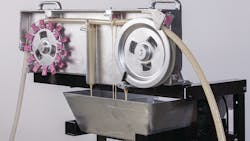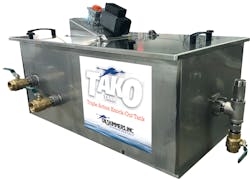Turning fat, oil and grease in wastewater into an efficient profit center
In the food processing industry, there are many different applications in which oils that are used or produced can end up in the wastewater stream. Some facilities extract oil from seeds and nuts. Some use oils in ingredients or for frying food. In applications where meat is cooked, fat and grease render out and collect in grease traps. Even the routine washdown of processing equipment surfaces can create a mixture of oily water.
Regardless of the source, removing accumulated fat, oil and grease from wastewater presents significant challenges. Food processors must implement efficient and cost-effective oil separation and removal solutions to treat wastewater on-site or discharge it to the sewer in compliance with federal, state or municipal regulations. If not, companies incur increased costs for water treatment and discharge, as well as ongoing maintenance.
In addition, food processors may be missing out on an important potential revenue source: when efficiently removed from wastewater, oil can be sold at a significant profit to companies that refine or repurpose it for reuse.
Fortunately, there are solutions that effectively and efficiently remove oil from water. When fully integrated, these oil-water separation and skimming systems can save food processors significant time, energy and costs.
Removal of free-floating surface oil
When fats, oils and greases are able to effectively separate from water — forming two distinct layers in a tank, sump, pit, etc. — they can be removed at this location. However, many methods of oil removal are inefficient and have limitations. These include:
Overflow methods
With displacement, operators raise the water level so that oil floating on the surface overflows a weir into a channel leading to an adjacent collection tank. However, this can be an inefficient technique that does not fully recover all the oil from the tank, takes quite a bit of time and can be prone to maintenance. In addition, the displaced oil will contain a large amount of water, which compromises its resale value or increases disposal costs.
A floating weir can also be used to suck the oil from the top of the water. While this can remove large quantities of oil, it is a time-consuming method that requires frequent hands-on attention. It also does not efficiently skim just the oil from the water. As with the overflow method, large quantities of water are collected, which reduces the value of the waste oil that can be reclaimed and sold and increases disposal costs.
Vacuum trucks
Free-floating oil can also be removed using contract vacuum removal services. In this approach, technicians pump out the oil and remove it from the customer site. These services charge a high, recurring fee, and frequent visits are required. Also, since vacuum truck services often charge by volume and the vacuum sucks up water along with the waste oil, customers end up paying for water to be hauled away with the oil.
Optimizing removal with oil skimmers
A more efficient, cost-effective alternative is an oil skimmer that uses a free-floating collector tube that continuously removes the oil and grease as it rises to the surface of the water.
Oil, fats and grease adhere to the outside of this floating collector tube as it moves across the surface. A series of scrapers on the oil skimmer removes the oil, which then drains by gravity into a collection vessel. This system is not sensitive to level fluctuation or floating solids on the surface, removes very little water and operates continuously and unattended, requiring minimal maintenance.
One successful example of oil skimmer use involves Brakebush Brothers, a family-owned manufacturer of frozen, cooked chicken products. The frozen food producer upgraded parts of its wastewater treatment system to accommodate increased production. In the process, the company installed a free-floating collector tube oil skimmer to recover used cooking oil from wastewater.
The problem was that large slugs of oil were “causing chaos” in the plant’s wastewater treatment system. As a solution, Brakebush Brothers purchased two Model 6V Brill oil-recovery systems from Cleveland-based Oil Skimmers, Inc. to remove oil from the wastewater before it entered one of the site’s two lift stations.
The oil-recovery system enabled Brakebush Brothers to eliminate the need for additional chemical treatment and reduced the volume of solid waste removed by the dissolved air flotation (DAF) system. Each skimmer removes 1,392 pounds of oil each day, which is recycled at a substantial profit to a company that manufacturers biodiesel from used cooking oil.
Another successful example of oil skimmer use involves tamale production at a major food plant in the southern United States. During production, the filling meat is cooked, which renders out the fat. Between batches, the fat is drained, and the cooking equipment is cleaned. The grease flows with the wastewater to a large grease trap.
With no continuous oil removal solution, the grease trap became routinely overwhelmed with buildup, and oily wastewater was being sent to the city’s treatment plant. In addition to increasing fees to treat the contaminated water, the city required regular testing of the wastewater at a cost of approximately $1,000 per visit.
The plant then hired a grease removal company to clean the surface of its 2,500-gallon oil/water separation tank at a cost of more than $8,000 annually. This did not eliminate the need for daily servicing of the grease traps or eliminate city treatment and testing fees.
In search of a better alternative, the plant turned to a custom Enclosed Skimming System (ESS) from Oil Skimmers Inc. Because the underground grease trap featured a unique manway opening (the tank’s only access point), a special adapter plate had to be designed so the skimming system could mount securely atop the opening. The system completely encloses the Model 6V oil skimmer, keeping the oil removal process contained and mess-free.
Now, as the grease rises to the surface in the grease trap, it is immediately recovered by the skimmer’s free-floating collector tube and then flows to a collection tote. The new oil removal solution continually skims the water’s surface and eliminates any potential of releasing contaminated, oily water.
With the new ESS functioning, the plant’s water quality improved so dramatically that the city lifted the water testing requirement, eliminating the monthly fees.
Today, the system delivers 275 gallons of recovered grease to a tote each week, which the company sells for a profit instead of paying for its removal. In the first year of operation alone, the system saved the company approximately $20,000, not including the additional revenue from selling the recovered grease.
Efficiently removing emulsified fats, oil and grease
At facilities where there is no existing tank or sump where wastewater collects and oil is not floating freely on the surface, an oil-water separator with an integrated skimmer may be the most practical solution. This type of equipment is designed to provide the necessary conditions to allow the efficient separation of the oil and water.
Several factors of the customer’s application dictate the ultimate design of an efficient system. A major problem faced by the food processing industry is that much of the equipment sold today does not take every factor into consideration: flow rate; specific gravity of the fat, oil and grease to be removed; temperature; percent of oil solids in the total flow; and continuous active oil removal. For example, when there is a high percentage of oil in the total flow, traditional oil-water separators can demand extensive maintenance and/or fail.
To address applications with high concentrations of oil, which occur often in the food processing industry, Oil Skimmers Inc. has invented a unique oil-water separator that features triple action knock out (TAKO). The system quickly reduces initial excessive oil levels, while providing effective oil separation and active oil removal in a single comprehensive system.
In the first oil “knock out” stage, the percentage of waste oil in the water is rapidly reduced to ensure efficient performance of the entire system. The water flows into the next chamber, where any remaining oil droplets are separated through a coalescing process. When oil droplets coalesce, they become larger and more buoyant and rise to the surface where the integrated tube type oil skimmer actively and continuously eliminates the oil. The active oil removal feature prevents oil buildup that results in a host of performance issues for other separators.
This Oil Skimmers Inc. oil-water separator was installed at one of the largest producers of taco shells, tortillas and tortilla chips in the U.S. The company faced an oil removal challenge with oil-to-water ratios of up to 90% in its production process, so standard equipment was not sufficient.
This system significantly improved operations and productivity for the tortilla producer. The tank operates continuously with little to no monitoring or maintenance. As a result, employees can spend their time and labor on more profitable food processing tasks and responsibilities.
The good news for food processors is that there are excellent solutions on the market that efficiently remove oil from water across a vast range of possible applications. This not only facilitates economical compliance with regulatory standards but also improves overall operations, minimizes maintenance and prevents fouling of filters and other wastewater treatment equipment. In addition, processors can save considerable money on water treatment and discharge, unnecessary chemicals and labor costs, while turning a tidy profit recycling waste oil.
Del Williams is a technical writer based in Torrance, California.
Oil Skimmers Inc.
About the Author
Del Williams
Del Williams is a technical writer based in Torrance, California.

